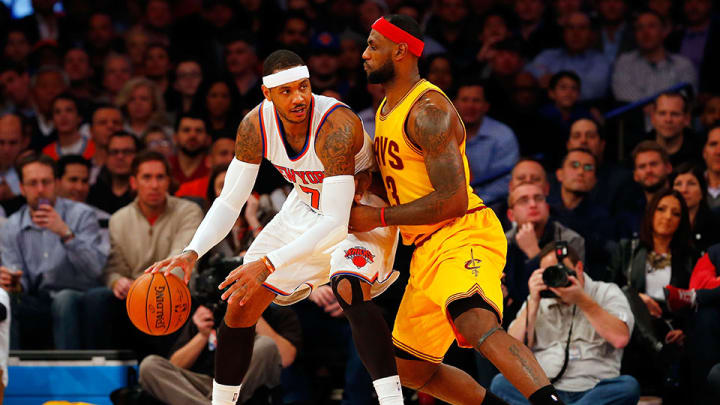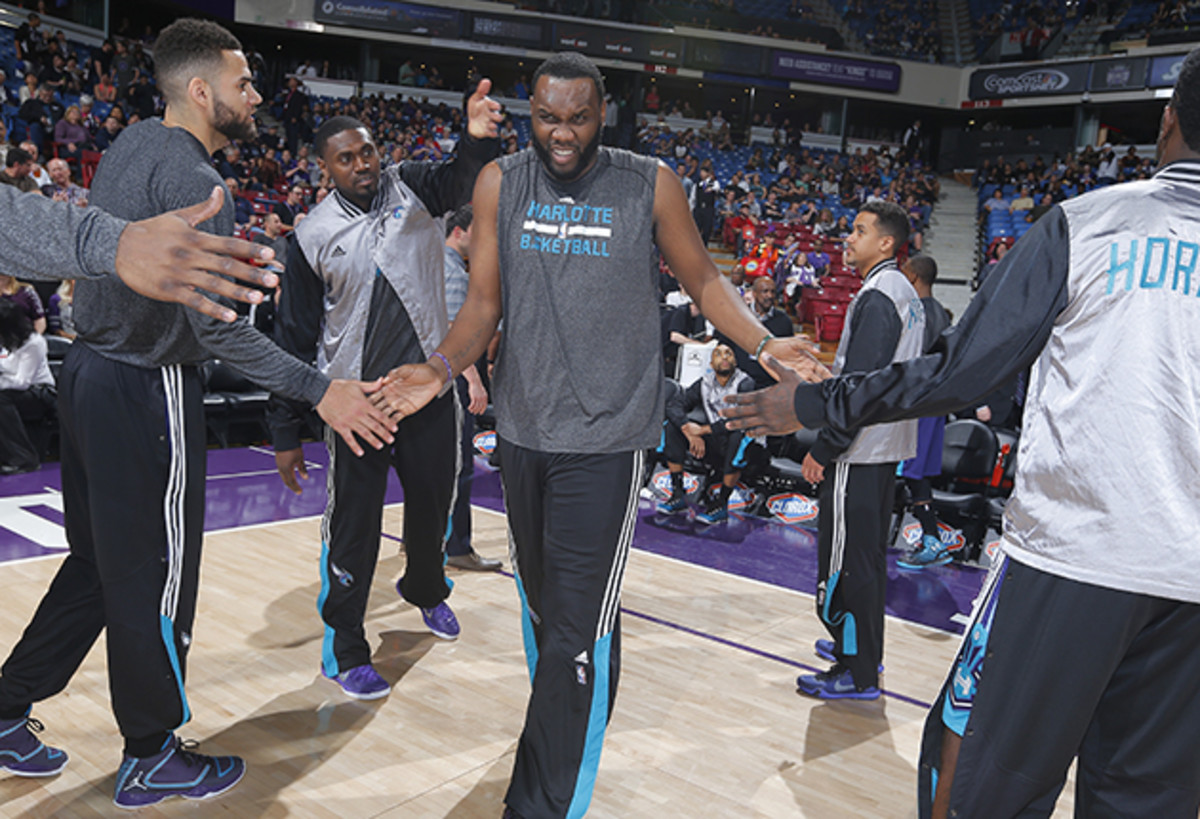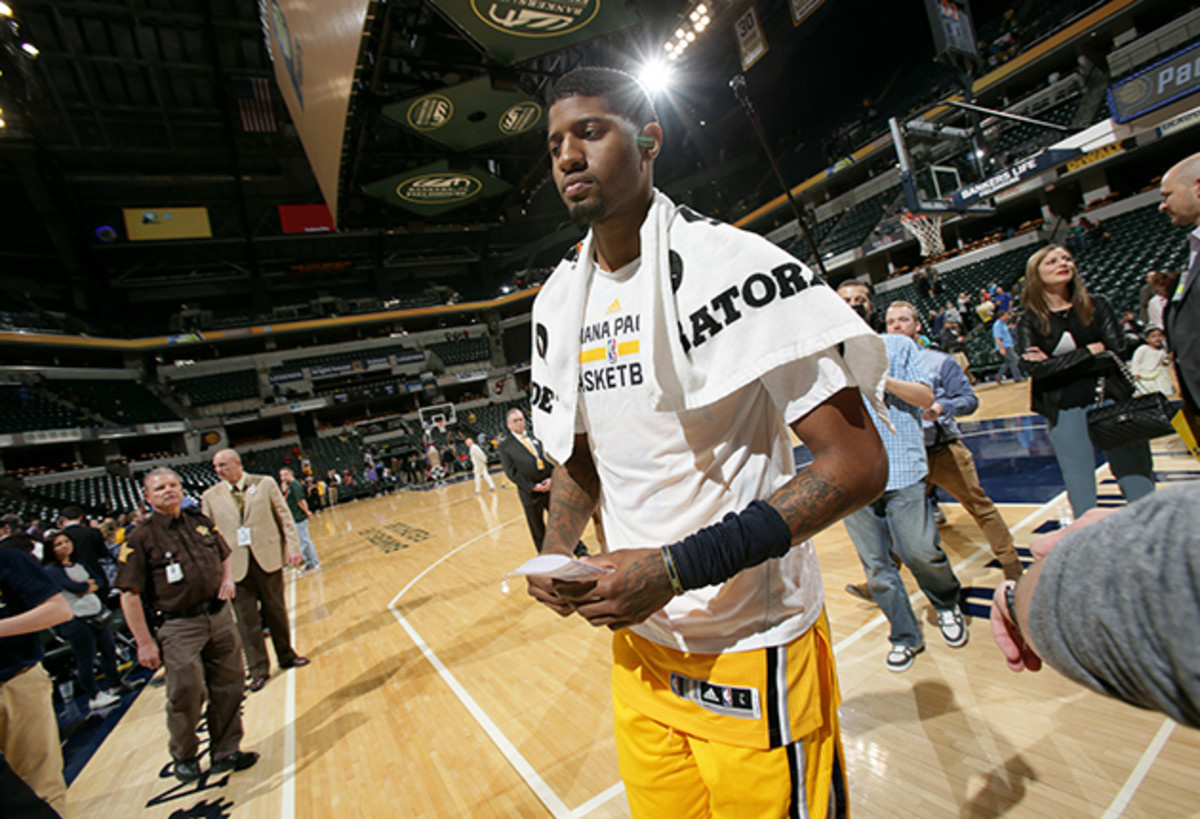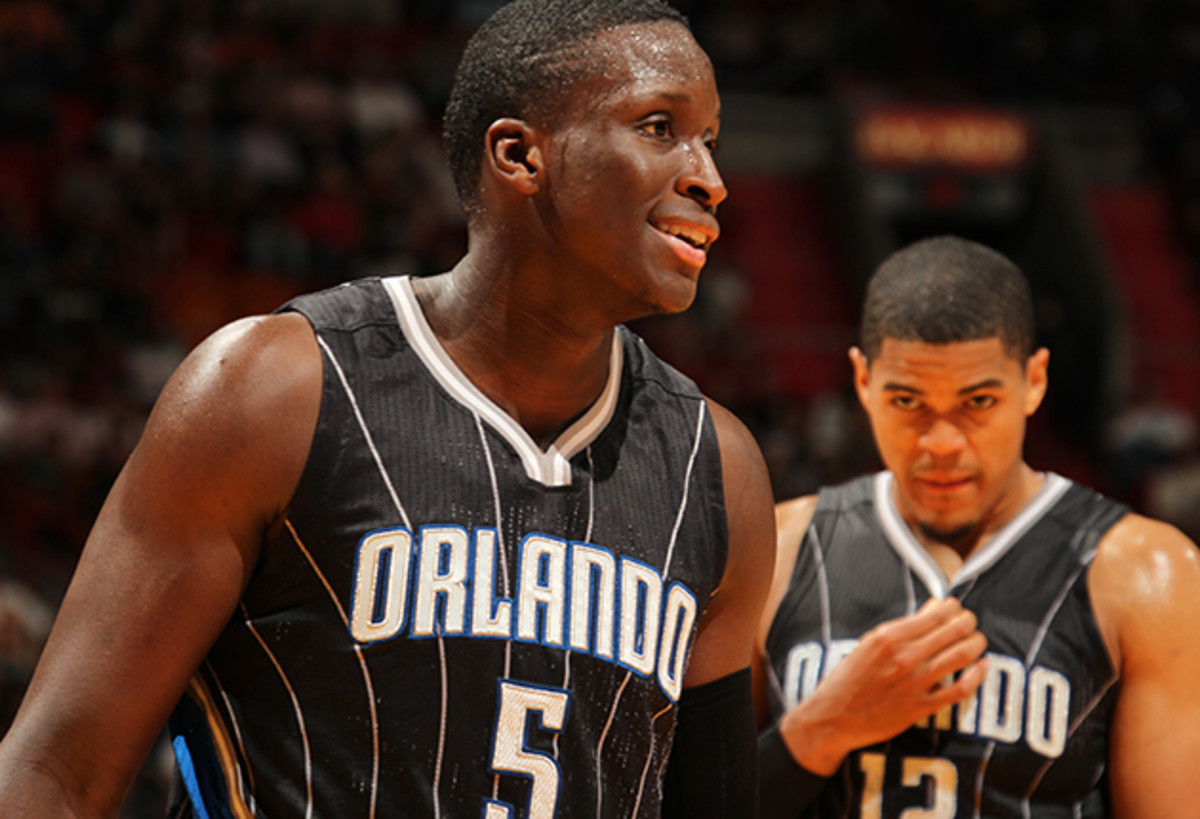NBA training camp storylines: Eastern Conference

The start of the NBA's training camps marks the unofficial start of basketball season. With that comes the courting of uncertainty; the same breadth of possibilities that allows fans of every team to embrace optimism also calls to the forefront the ambiguities that every team must face. Today we survey those variables soon to be in play for every team in the Eastern Conference.
Atlanta Hawks
Can Atlanta’s developmental system again yield a starting wing?
While DeMarre Carroll worked hard to set the market for the $58 million contract he inked this summer, the Hawks’ coaching staff is owed a small percentage of the royalties. Carroll, famously, had made just 27 three-pointers in his entire career prior to his arrival in Atlanta. Yet the Hawks’ scouting and developmental teams saw the kind of shooting structure that could be quickly honed. Carroll was entrusted to fire away from the perimeter and made 97 threes in his first season with the Hawks on 36.2% shooting from beyond the arc. He followed that up with 120 made threes on 39.5% shooting the year after. Atlanta had taken a player of clear skill as a defender and rebounder and augmented a hidden ability almost instantly.
Off-season grades: Southeast Division
Now, with Carroll gone and no obvious replacement on the roster, the same staff that sharpened Carroll’s game to shocking proficiency is under pressure to again do the same. The leading candidates are Kent Bazemore, whose length and athleticism belies tantalizing potential; Justin Holiday, a defensive prospect with little offensive game; and Tim Hardaway Jr., who wore out his welcome with the Knicks despite evident offensive skill. If any are capable of a Carroll-like transformation, Atlanta’s staff will surely identify and groom that potential.
Boston Celtics
Who starts, who comes in off the bench, and who falls out of the rotation entirely?
Brad Stevens comes to training camp in the enviable (or is it unenviable?) position of having a blank-slate lineup card. As many as four starters could potentially change from the end of last season. New additions also call into question which reserves will be regular fixtures and which might end up as merely occasional contributors. Nothing is set with a roster this balanced and this deep—all of which leaves a shocking amount of ground to be gained or lost in training camp.
For starters: the arrival of Amir Johnson and David Lee will surely spell a minutes reduction for one of Boston’s young bigs. None among Tyler Zeller, Kelly Olynyk, and Jared Sullinger are safe; any of those three could become an afterthought on a game-by-game basis, though one of the three figures to be a more regular benchwarmer. The backcourt, while not quite so deep, is malleable still with Marcus Smart and Isaiah Thomas both making credible claims to start at point. Some combination of Jae Crowder, Avery Bradley, and Evan Turner would start alongside the point of choice—though which is best suited for the job varies depending on the point guard chosen. Stevens has lots of player synergies to sort through and play around with and no pressure to set a starting five immediately. Expect trial runs of various player combinations.
Brooklyn Nets
Will any of Brooklyn’s fliers prove reliable?
Brooklyn had neither the cap space, the draft picks, nor the trade fodder to significantly upgrade its roster this offseason. Instead it chose to spend prudently— something the Nets had never done (or seemingly even considered) under the ownership of Mikhail Prokhorov. Brook Lopez and Thaddeus Young were re-signed to modest deals. Deron Williams was bought out to bring the Nets under the luxury tax line. And a handful of players were brought in on minimum or near-minimum contracts as calculated gambles.
Not all of those players will pan out. Yet between Wayne Ellington, Andrea Bargnani, Shane Larkin, Thomas Robinson, and Donald Sloan, the Nets have a variety of potential contributors on bargain deals. None of the five has played well enough to this point as to have earned the benefit of the doubt. What they have instead is some interesting quality or another: a marketable skill, notable quickness, or size enough to warrant interest. Any of the five could give a little spice to a roster that otherwise seems stale.

• MORE NBA: Hornets' Jefferson drops 25 pounds
Charlotte Hornets
Will there finally be enough space for Al Jefferson to operate freely in the post?
Operating a low-post offense demands that a team also build a roster of perimeter shooters—a very necessary counterbalance that protects against defenses overloading the interior. That kind of clutter seems to follow Al Jefferson wherever he goes; Charlotte failed to adequately space the floor during Jefferson’s two years there, though the same could be said of his previous stints in Utah and Minnesota. Building an optimal offense around a post-reliant player like Jefferson might be easier said than done, though no team yet has given Jefferson even an adequate amount of working room.
That could feasibly change this season, depending on what you make of Charlotte’s latest imports. Most notably, the Hornets traded Gerald Henderson (who topped out, distance-wise, as a midrange shooter) and Noah Vonleh for the rangier Nicolas Batum. Lance Stephenson, who made just 17.1% of his three-pointers last season, was shipped out for perimeter-oriented big Spencer Hawes and Matt Barnes—the latter of whom was flipped for a better shooter in Jeremy Lamb. Even Frank Kaminsky, whom the Hornets drafted with the No. 9 pick, could conceivably contribute to a better-spaced offense or even extend his range beyond the three-point arc. Charlotte, at the very least, has options in balancing and constructing its rotation that it never had before. Jefferson’s post work may breathe easier yet.
Chicago Bulls
How will Chicago’s changes shape its frontcourt rotation?
Internal forces at work within the Bulls’ roster and the hiring of Fred Hoiberg to succeed Tom Thibodeau as head coach coincide to bring upheaval to Chicago. The very nature of the team’s offensive and defensive systems are changing and with it the needs of each position. Nikola Mirotic seems a better fit for the Bulls of the future than he did the Bulls of the past. Pau Gasol and Joakim Noah may not, within Chicago’s new structure, have much business playing in the same lineup. There’s a lot to suss out in finding roles and allocating minutes to four very capable bigs—five if you include rookie lightning bolt Bobby Portis. Training camp will presumably be the setting for those implementations, even if many of the decisions behind them have been considered and toyed with for months.
Bulls' Mike Dunleavy undergoes back surgery, out 8-10 weeks
Two particular points of leverage are the minutes averages of Noah and Mirotic. If Noah’s play leans uncomfortably toward the injured, debilitated form we saw to close Chicago’s season, he could very quickly find himself head toward rotation irrelevance. If not, the prospect of him averaging better than 30 minutes a game seems doubtful both for the sake of changing the Bulls’ base structures and preserving Noah’s body as best as possible. Mirotic, though a wildly different player, could be the beneficiary. Whether the Bulls are interested in spacing the floor, adding more dynamism, making their offense less predictable, or striking a better balance of scoring and passing, Mirotic would seem to be Hoiberg’s best option available.
Cleveland Cavaliers
Does the start of camp accelerate negotiations with Tristan Thompson?
The gridlock between Thompson’s camp and the Cavs drags on with a reported $14 million—along with the principle of the thing—hanging in the balance. To more fully understand that divide, parse our walkthrough of why Thompson is an especially difficult player to evaluate under these circumstances.
Beyond that, Cleveland now must deal with the chatter that comes with a training camp holdout. Both parties will be pressured toward resolution. Thompson would naturally be eager to get back on the court and will surely be in touch with some his teammates; the Cavaliers have every incentive to get an important player back into the mix as they prepare for the season. With one blink this could all be over.
Detroit Pistons
Is there enough stretch to the Pistons’ stretch fours?
Much has been made of Detroit’s changing structure and for good reason: Parting ways with Greg Monroe and replacing him with more perimeter-oriented big men will dramatically change the way the Pistons operate. That said, the team’s most likely options at power forward (Ersan Ilyasova and Anthony Tolliver) are good shooters but not great ones.
Some opponents will nonetheless react to the threat of their jumpers as intended and open up lanes for Andre Drummond and Reggie Jackson in the process. Others will force Ilyasova and Tolliver to beat them while contesting those shots as best they can—a dicey proposition if those bigs are shooting around league average. Those two (or any small forward shifting up to log minutes at the four) will need to hit a critical number of shots to keep defenses honest. Whether they’re capable could mark the difference between playoff qualification and yet another trip to the lottery.

• MORE NBA: George aspires to win MVP
Indiana Pacers
How comfortable (and how healthy) can Paul George be logging big minutes at power forward?
George has yet to start a single game as Indiana’s power forward and already he has made his reluctance known. It’s hard to blame him; moving George to the four both takes him away from what he does best (clamp down on perimeter scorers) and lines him up for a new physical toll. How he and his body take to those changes will be an important development for a Pacers team otherwise light on reliable big men. Playing George in that spot is as much about experimentation as it is desperation; George may well be the best option for the position despite having never consistently played it before.
Even if George comes to accept a stretch four role as his lot in the NBA, it’s possible that his recently recovered leg might not hold up well against the rigors of banging against bigs, enduring aggressive box-outs, and standing in the way of full-speed dribble penetrators. George has his work cut out for him, regardless, and every reason to keep close tabs on his ongoing physical maintenance.
Miami Heat
Just how good can this core be?
Even with breakout center Hassan Whiteside playing on a minimum contract, the Heat have some $68 million in salary committed to their starting five alone this season. The payroll of their full roster stretches over $90 million and the cost after luxury tax payments is far higher. All of which is to say that a sharp organization has made an expensive wager on this particular group of players—a reasonable one considering the talent involved.
Happy and Healthy: Chris Bosh values life after near-death experience
Miami, even if forced to fight through some injuries, should be a significantly better team. The addition of Goran Dragic makes the Heat’s creative core more robust; an injury to Dwyane Wade or Chris Bosh could be weathered much more effectively now that Dragic is around to sop up some of their possession usage and tilt the offense in a slightly different direction. Some reasonable skepticism is in order, however, before lumping Miami in with Cleveland in the East’s top tier. That potential exists given the caliber of players—both starters and reserves—involved. It’s just difficult to know exactly what this group is capable of given all of the variables involved.
Milwaukee Bucks
Can the Bucks hold their defensive ground?
The second-best defensive team in the league last season added two significant pieces (Greg Monroe and Greivis Vasquez) while returning another (Jabari Parker) from season-ending injury. The catch? None among them are great defensively, even in the context of a long, athletic team that makes a lot of headway by pressuring the strong side of the floor. There are reasons to believe that Milwaukee’s particular style of defense could be more accommodating of each player’s limitations than other systems might be. Nevertheless, the Bucks may not have enough margin for error to immediately incorporate those three players while keeping on pace for a top-six seed.
That has as much to do with Milwaukee’s offense, which to this point has been concerningly ineffective. Monroe, in particular, will help; if nothing else, the Bucks now have a proven interior scorer who can facilitate from the middle of the floor. Yet the baseline from which Milwaukee is operating is its 97.5 points scored per 100 possessions after trading away Brandon Knight at the trade deadline. That was the fourth-lowest mark in the league over the final stretch of the season, and even some sizable improvement upon it would require the utmost precision from Milwaukee’s defense to keep a competitive pace.
New York Knicks
Just how ready is Kristaps Porzingis?
New York has a handful of options in filling its starting power forward role, but none of them are optimal. Carmelo Anthony could slide over to the four but in the process highlight the Knicks’ lack of quality wings. Derrick Williams could conceivably fill the spot to energize New York’s floor game though without many triangle-ready skills. Kyle O’Quinn, who has played some power forward in the past, could assume the spot to supersize the Knicks’ lineup but slow it considerably.
It appears Knicks coach Derek Fishermay opt for none of the above and start 20-year-old rookie Kristaps Porzingis instead. The underlying idea is smart; burying Porzingis in the rotation would be folly for a team in New York’s position, seeing as the Knicks aren’t good enough to justify holding out such an important part of the team’s future. We’ll find out soon enough if Porzingis is ready to bear that kind of responsibility.

• MORE NBA: Ridnour to sit out the season
Orlando Magic
How will a young team take to the introduction of a new system?
What was one of the most disorganized teams in the league last season will be introduced to a coach committed deeply to rigid order. Scott Skiles is a good basketball coach with very particular wants; Orlando’s players will soon be told (or scolded, depending on Skiles’s mood) their exact responsibilities and held to those standards on a minute-to-minute basis. Some of the Magic’s young players will do well with that kind of structure and others will buckle beneath the weight of it.
The particulars of those reactions could determine who plays for Skiles and who doesn’t or, eventually, who sticks around and who moves on. One can’t well judge the final product of a team’s reinvention by its earliest days. There’s something to be learned, though, from parsing which players seem to take to a new system on its most basic levels—particularly when a coach as uncompromising as Skiles is involved.
Philadelphia 76ers
Can the Sixers’ two top prospects work in tandem?
Nerlens Noel might be the springy, quick-footed shot-blocker that Jahlil Okafor needs to play alongside to thrive in the NBA. He also might be a detriment to everything that Okafor attempts to do offensively, given that opponents have no real reason to guard Noel once he strays further than arm’s reach of the rim. That these are the two best prospects on Philadelphia’s roster gives their relationship some added stakes. Sam Hinkie’s tenure as Sixers general manager shouldn’t be judged on whether or not Noel and Okafor can play together, though their level of compatibility will surely shape the timing and motivations of Philadelphia’s plans.
Video: Charles Barkley gives eulogy at Moses Malone’s funeral
With the way this front office navigates the trade market, it wouldn’t be especially shocking to see either Noel or Okafor moved during the course of the season. Perhaps they can come together quickly enough to make a case for playing as a pair—a showing of compatibility that could quiet the naysaying and ease the hand-wringing over Philly’s stockpiling young players of similar positions.
Toronto Raptors
Can Toronto salvage its team defense?
Toronto’s regression over the course of last season was especially stark on the defensive end. It was there that Kyle Lowry ran out of gas completely, that DeMar DeRozan’s injuries forced an overreliance on Lou Williams, and that the bigs could never strike the right balance. The biggest move of the Raptors’ summer seemed to be an address of this point, bringing in tough defenders at the point (Cory Joseph), on the wing (DeMarre Carroll), and at the rim (Bismack Biyombo).
Even still, the Raptors face their need for defensive improvement without a clear anchor. The team’s two presumptive starting bigs (Jonas Valanciunas and Patrick Patterson) are in some ways the shakiest defenders among the starters. Even on their better days last season, neither Valanciunas nor Patterson would have been confused for an above-average defender. That could change with practice, maturity, and systemic adjustment, though the Raptors will have their work cut out for them in a larger sense when it comes to building a more stable team defense.
Washington Wizards
Just how committed are the Wizards to adjusting their style of play?
Every bit of Washington’s small-ball success would suggest that more of the same is coming—that Randy Wittman, at long last, might be ready to move away from some of the Wizards’ clunkier lineups as a means of jump-starting their offense. The trade to acquire Jared Dudley and Washington’s wing signings would seem to underscore that point; while one can never have too many shooters around, the Wizards gave up a conventional big (Kevin Seraphin) this summer while getting quicker, smaller, and more accurate from the perimeter.
There are mitigating factors that would prevent Washington from leaning into the small-ball revolution fully, not least of all the presence of a solid, traditional power forward in Nene. What training camp and the preseason should show is the level of small-ball commitment one can expect of the Wizards this season. It’s not just about who’s starting, but who might finish games, how malleable the lineup might be on a night-to-night basis, and whether Washington might default back to the safety of what it knows at the first sign of significant trouble.
